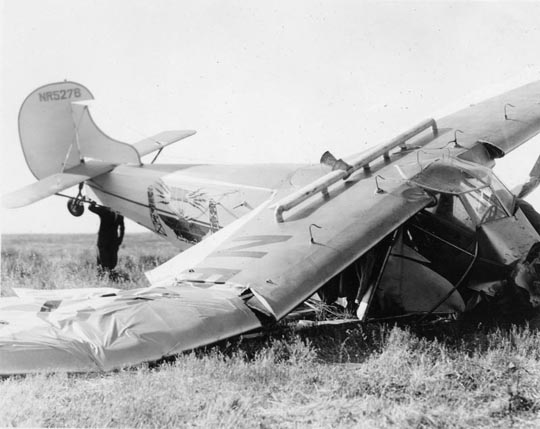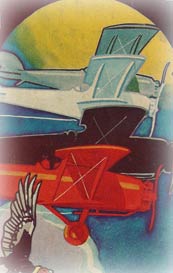|
Registration Number NC5278
A Nice Way of Saying It: This Is An
Airplane With A Very Curious History
This aircraft is recorded in NASM records as a Warren &
Montijo monoplane, S/N W.M.1. It was manufactured in April
1928 by H.P. “Glen” Warren & John G. Montijo,
San Luis Obispo, CA, as a class project at California Polytechnic
College under the instruction of Warren and Montijo. There
was no ATC # assigned (i.e. it was not certified by the CAA).
It was constructed with steel tubing fuselage and tail group,
and spruce and Haskelite wings. Haskelite was a brand of molded plywood. It left the school/factory with a
260 HP Salmson (Menasco) 9-cylinder 92M air-cooled engine.
In what has to be a mistake of record transcription, the empty
weight is given as 3,032 pounds and gross weight of 3,355
pounds, leaving a useful load of 323 pounds. This is probably
an error, as the airplane was billed as carrying two pilots
and four passengers, as well as, hopefully, some fuel.
On August 1, 1928 this airplane sold to C.B. Bellows, a Dodge automobile
dealer, of Long Beach, CA. The bill of sale called the airplane
a “Glenmont Landau Sedan” (Glenmont undoubtedly
being a combination of Glen Warren and John Montijo’s names).
Bellows stated that he preferred the name “Belmont”
and the name was changed on August 29, 1928. This is why the airplane
was identified as a Belmont in the Register. Further, on November 23, 1928
Mr. Montijo summitted an application to register “Belmont
Cabin Monoplane C/N M-1”. He had lowered the first station
at the rear of the engine to improve frontal visibility. The
total time on the aircraft to that date was 44 hours. No bill
of sale was generated, leading the CAA to question the application.
Montijo explained, “Bellow still retains sole ownership
of the Belmont M-1. The plane was designed and built by me.
I engaged Mr. W.T. Waterhouse to figure the stress analysis
for it before the plane was sold to Mr. Bellows (stress analysis
recently sent to D.O.C.).” Further, he said he was building
more planes, desired approval of this model only, and that
future planes will be slightly changed in design and a new
complete set of drawings will be sent by Waterhouse for approval.
Near this time, on March 10, 1929, NC5278 landed at Tucson piloted
by Mr. Montijo. He carried three unidentified passengers, arriving from
Phoenix and returning to Phoenix.
The airplane was sold, less engine, three months later,
on June 26, 1929, to J.G. Melson of Los Angeles, CA. The airplane
was still located in the Bellows hangar at Long Beach Municipal
Airport. On August 12, 1929, Melson reported that the sale was, “not
consummated and in litigation due to misrepresentations.”
No bill of sale was submitted.
Assuming the owner still to be Bellow, the airplane was sold
on July 16, 1932 to Monty G. Mason of Los Angeles. Record says,
“airplane is of a blue and silver color, but at the
time (of sale) has, at the instigation of the buyer been painted
by the Arborgast Aero Service to green and gold.”
Then, in a series of confusing transfers, the airplane, Belmont
S/N W.M.-1, registration 5278, was rebuilt and emerged as
a Mason Greater Meteor, S/N M-200. It was identified as having
the, “same wing and remodeled fuselage with different
motor”, and said to have been “manufactured”
as a single-seat aircraft by Mason Aircraft Co. as of November 23, 1933
with a 420 HP Pratt & Whitney Wasp engine S/N354 and 348
gallons fuel capacity. It had a, “broadcasting booth
and refueling equipment” in the passenger compartment
(six tanks). Mason requested a restricted or “R”
registration on February 27, 1934, and designated it for a, “non-stop
refueling endurance distance flight.”
NR5278, ca. April 1934
(Source: Mason)
 |
On April 29, 1934, the aircraft was in an accident at Long Beach.
Damages were not stated in the NASM record, but the image above,
courtesy of Dave Mason, is self-explanatory. Note the plumbing
array on top of the wing to support the aerial refueling
operation. You can see a rounded hatch behind the rearward- facing
intake nozzle where an assistant probably stood to grapple
with a wind-whipped refueler hose from an aircraft flying
close overhead. The six down pipes probably fed the six fuel
tanks individually. What a way to make a living!
Below is a detail fo the graphic on the side of the fuselage.
It reads, "WORLD'S FIRST AERIAL BROADCASTING STATION". Below
the logo is "Pride of Hollywood".
Detail of Fuselage Side
(Source: Mason)
 |
The NASM record goes on to say that a memorandum
dated May 8, 1934 states that reports of spectators and inspectors
indicate that the accident was due to the flying ability
of Mason. Mason’s
own report suggests the possibility that the ship was not
airworthy in terms of stability as apparently the center
of gravity was out of line (statement: “At
about 50 feet a terrific oscillation was set up in the
tail section and….had a tendency to corkscrew. At
about 500’
I made a right turn…still maintaining complete left
rudder and left aileron to avert a power spin.” Mason
was cited on May 10, 1934 in violation of the Civil Aviation
Regulations (carrying a passenger in a NR, "Restricted" licensed airplane). His transport pilot’s
license (#29953) was suspended for 60 days.
The registration was cancelled on July 18, 1934. Title passed on
July 18, 1934 to W.O. Buchanan, a mechanic, A&E #12539. The
aircraft remained in hangar 15 at the Long Beach airport at
least until October, 1935. No further information.
You will note at this link to aerofiles.com, that Mr. Mason submitted the information above for posting on aerofiles in 2007.
---o0o---
THIS PAGE UPLOADED: 06/05 REVISED: 12/11/06, 06/11/10
|

